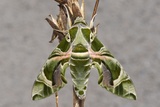Daphnis nerii (Linnaeus, 1758) Species
Last modified: Oct. 18, 2025, 3:55 p.m.
A very rare vagrant in Belgium. Due to the current import of Nerium oleander, the species is seen almost every year.
2016 was a good year with a handful of observations of larvae, but 2024 beats this with many sightings of larvae and adults.
Details
- Classification
- Family: Sphingidae > Subfamily: Macroglossinae > Tribus: Macroglossini > Genus: Daphnis > Species: Daphnis nerii
- Vernacular names
- Oleanderpijlstaart (NL), Oleander Hawkmoth (EN), Le Sphinx du Laurier-rose (FR), Oleanderschwärmer (DE)
- First mention in Belgium
- De Sélys-Longchamps E. 1837. Catalogue des Lépidoptères ou Papillons de la Belgique, précédé du tableau des Libellulines de ce pays. — — : 1–29. On page 22 (as Deilephila Nerii). view page
- Status
-
Migrant
A very rare migrant, but almost present every year.
Distribution
Egg
The pale green, shiny egg-shaped eggs are laid singly on both the upper and lower surfaces of young leaves on the host plant. Hatching takes 5 to 12 days according to temperature.
Caterpillar
The dimorphic larva is green or brown and full-fed caterpillars reach 10 to 13 cm. Newly-hatched larvae (3–4mm), consuming their eggshells, are bright yellow with an unusually long, very thin, blackish horn. The older caterpillar bears a prominent eye spot on its third thoracic segment and a pale dorsolateral line from abdominal segment 1 to the horn which is stout and curved downward in the final instar.
Bionomics
The caterpillars of this species are strongly associated with Oleander and almost all caterpillar finds are made on this scrub and live free on the leaves. Despite their impressive appearance, they are well camouflaged among the oleander leaves. Their presence is often indicated by large droppings that lie beneath the food plant.
The larvae are not able to hibernate in our country due to the harsh conditions.
In the Mediterranean South, they usually overwinters as a pupa and pupate in a loose cocoon that they make from leaves and other plants. In the tropics, the species is continuously brooded because there is no overwintering stage. They can often be found on the ground or in the litter layer. Most emerge late in the evening but do not take flight until just before dawn.
The adults rest during the day, either on a solid surface or suspended among foliage material. Rarely found at light.
Flight periods
The adults fly from May till late October.
Observed on
- Host plant (species):
- Nerium oleander and Vitis vinifera
- Host plant (genera):
- Vinca
The larva lives mainly on the flowers, twigs, and leaves on Nerium, in captivity also accepts Ligustrum and Vinca.
Habitat
Prefers dry riverbeds, oases, and warm hillsides with scattered oleander bushes, roadsides, and gardens with cultivated oleander.










